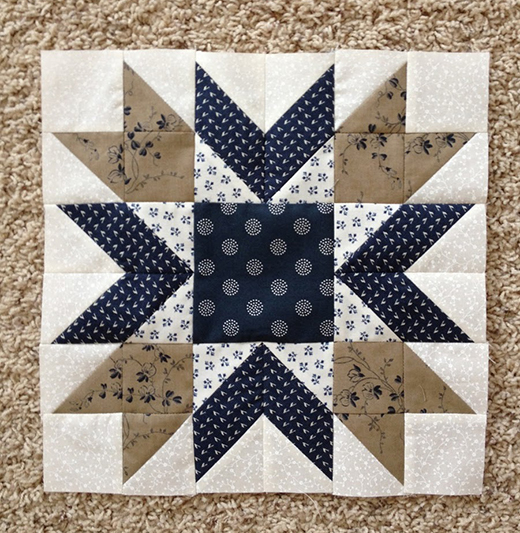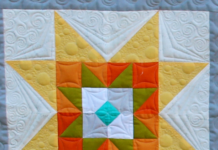Quilting has always been more than just a hobby for me; it’s a deeply rooted passion that connects me to the moments of calm and creativity in my life.
I remember the first quilt block I ever made—a patchwork of blues and reds that came together like a piece of a puzzle. It was called “Blueberry Pie.”
This block wasn’t just a practice in sewing techniques; it was a lesson in patience, color theory, and the joy of creating something beautiful from scratch.
The Blueberry Pie block remains one of my favorites to this day, not only because of its aesthetic appeal but also because of the memories it evokes—memories of quiet afternoons filled with the rhythmic hum of my sewing machine and the satisfaction of completing a project with my own hands.
Capturing the Essence of the Blueberry Pie Block
The Blueberry Pie quilt block is all about striking the perfect balance between symmetry and color. Its design features a central square surrounded by a series of triangles and smaller squares, which come together to create a dynamic and eye-catching pattern.
What makes this block particularly special is the interplay of colors—using shades of blues, reds, and yellows to create a visual effect that resembles a freshly baked blueberry pie.
Materials Needed for the Blueberry Pie Quilt Block
To create a Blueberry Pie quilt block, you’ll need the following materials based on the size of the block you choose to make (12”, 9”, or 6” finished):
For a 12” Finished Quilt Block:
- Background Fabric 1:
- Cut 4 squares, each 2 ½ inches.
- Cut 8 squares, each 2 ⅞ inches, and bisect on one diagonal.
- Cut 1 square, 5 ¼ inches, and bisect on both diagonals.
- Fabric 2:
- Cut 4 squares, each 2 ⅞ inches, and bisect on one diagonal.
- Fabric 3:
- Cut 4 squares, each 2 ½ inches.
- Fabric 4:
- Cut 4 squares, each 2 ⅞ inches, and bisect on one diagonal.
- Cut 1 square, 5 ¼ inches, and bisect on both diagonals.
- Fabric 5:
- Cut 1 square, 4 ½ inches.
For a 9” Finished Quilt Block:
- Background Fabric 1:
- Cut 4 squares, each 2 inches.
- Cut 8 squares, each 2 ⅜ inches, and bisect on one diagonal.
- Cut 1 square, 4 ¼ inches, and bisect on both diagonals.
- Fabric 2:
- Cut 4 squares, each 2 ⅜ inches, and bisect on one diagonal.
- Fabric 3:
- Cut 4 squares, each 2 inches.
- Fabric 4:
- Cut 4 squares, each 2 ⅜ inches, and bisect on one diagonal.
- Cut 1 square, 4 ¼ inches, and bisect on both diagonals.
- Fabric 5:
- Cut 1 square, 3 ½ inches.
For a 6” Finished Quilt Block:
- Background Fabric 1:
- Cut 4 squares, each 1 ½ inches.
- Cut 8 squares, each 1 ⅞ inches, and bisect on one diagonal.
- Cut 1 square, 3 ¼ inches, and bisect on both diagonals.
- Fabric 2:
- Cut 4 squares, each 1 ⅞ inches, and bisect on one diagonal.
- Fabric 3:
- Cut 4 squares, each 1 ½ inches.
- Fabric 4:
- Cut 4 squares, each 1 ⅞ inches, and bisect on one diagonal.
- Cut 1 square, 3 ¼ inches, and bisect on both diagonals.
- Fabric 5:
- Cut 1 square, 2 ½ inches.

Full Pattern: Click Here
Preparing to Start: Insights and Considerations
Before diving into the cutting and piecing process, it’s important to consider a few key points that will help ensure your success with the Blueberry Pie quilt block:
- Fabric Selection: Choose fabrics with contrasting colors to emphasize the block’s design. The Blueberry Pie block traditionally uses a combination of blues, reds, and yellows, but feel free to experiment with different color palettes to suit your style.
- Accurate Cutting: Precision is key in quilting. Ensure your rotary cutter is sharp and your ruler is reliable to make precise cuts. This will help maintain the block’s symmetry and design.
- Seam Allowance: Maintain a consistent ¼ inch seam allowance throughout the project. This consistency is crucial for ensuring all pieces fit together correctly and the block lays flat.
- Ironing: Press your seams as you go to keep the block crisp and flat. This also helps in accurately joining pieces together.
Now that you have all your materials ready and some initial tips in mind, you’re set to start constructing your Blueberry Pie quilt block. Let’s dive into the step-by-step instructions in the next section.
Step-by-Step Instructions for the Blueberry Pie Quilt Block
Step 1: Preparing Your Fabrics
- Cutting Your Fabrics:
- Begin by cutting all of your fabrics according to the sizes and quantities listed in the materials section. Remember to be precise with your measurements and cuts.
- For each size block, ensure that you have all pieces ready before you start assembling. This preparation will make the sewing process smoother.
- Bisecting Squares for Triangles:
- For the squares that need to be bisected (cut in half diagonally), use a rotary cutter and ruler to achieve clean, straight cuts. Place the square on your cutting mat, align the ruler from one corner to the opposite corner, and carefully slice through with your rotary cutter.
- Pressing the Fabrics:
- Once all pieces are cut, press your fabrics to remove any creases. This step helps in accurate piecing and ensures that your block will be neat and flat.
Step 2: Constructing Half-Square Triangles (HSTs)
- Pairing and Marking:
- Take your background fabric triangles (Fabric 1) and pair them with the corresponding triangles from Fabric 2 and Fabric 4. These pairs will form your half-square triangles (HSTs).
- If using a larger block size (12″ or 9″), you’ll have more HSTs to make. The 6″ block size requires fewer HSTs, so adjust accordingly.
- Sewing the HSTs:
- Place one triangle from the background fabric (right side facing up) and lay a contrasting fabric triangle on top (right side facing down). Align the edges carefully.
- Sew along the diagonal seam using a ¼ inch seam allowance.
- Press the seam to the darker side using an iron. Repeat this process for all triangle pairs.
- Trimming HSTs to Size:
- After sewing all your HSTs, trim them to the exact size specified for your chosen block size. This trimming ensures the triangles fit perfectly when piecing the quilt block together.
Step 3: Assembling the Corner Units
- Creating the Four-Patch Units:
- For the corners of the Blueberry Pie block, you will create four-patch units. Take the smaller squares of Fabric 3 and the HSTs you’ve just sewn.
- Arrange these pieces in a 2×2 grid: two HSTs diagonally opposite each other and two squares of Fabric 3 in the remaining spaces.
- Sew the squares in pairs, then join the pairs to complete the four-patch unit. Make sure to press the seams open or towards the darker fabric.
- Repeating for All Corners:
- Repeat the process to make four corner units in total. These will form the corners of your Blueberry Pie quilt block, adding to the symmetry and balance of the design.
Step 4: Constructing the Center and Side Units
- Building the Center Unit:
- For the center unit, use the largest square (Fabric 5). This piece should be prominently positioned in the center of your quilt block.
- Ensure this square is precisely cut and ready to be sewn with the surrounding units.
- Assembling the Side Units:
- The side units are composed of the remaining HSTs and smaller squares from Fabric 4. Arrange these pieces to form the side strips of your quilt block.
- Sew the HSTs and squares together in a row, then attach this row to the center square, aligning the seams carefully.
Step 5: Completing the Block Assembly
- Laying Out All Units:
- Lay out all the sewn units (corner units, center square, and side units) on a flat surface. This step is crucial to visualize the final layout and ensure all pieces are correctly positioned.
- The layout should have the center square in the middle, surrounded by side units, and corner units at each corner.
- Sewing Rows Together:
- Sew the side units to the center square, forming three rows (top, middle, and bottom).
- Next, sew these three rows together to complete the quilt block. Be mindful of matching seams and maintaining a consistent ¼ inch seam allowance throughout.
- Final Pressing:
- Give your completed Blueberry Pie quilt block a final press. Ensure all seams lay flat and the block measures the correct finished size (12″, 9″, or 6″).
Additional Tips for Success
- Chain Piecing: To save time, consider chain piecing your HSTs and four-patch units. This method involves sewing one seam right after another without cutting the thread, speeding up the process.
- Seam Ripping: If a seam doesn’t align perfectly, don’t hesitate to use a seam ripper and try again. Precision is key in quilting, and taking the extra time to fix mistakes will pay off in the final product.
- Starch and Pressing: Using a light spray of starch while pressing can help keep your fabric crisp and prevent fraying, especially when working with bias edges on triangles.
- Using Pins: Pinning at critical points, such as where seams meet, can help maintain alignment and prevent the fabric from shifting as you sew.
Creating the Blueberry Pie quilt block is a rewarding experience that combines technical skills with creative expression. As you piece together each square and triangle, you’ll find yourself developing a deeper understanding of color placement, fabric handling, and quilting techniques. The end result is a vibrant and dynamic quilt block that stands out in any quilting project.
Whether you choose to make a single block or an entire quilt using the Blueberry Pie pattern, each piece tells a story—a story of patience, craftsmanship, and the joy of creation. I hope you enjoy making this block as much as I do, and that it becomes a cherished part of your quilting journey.





